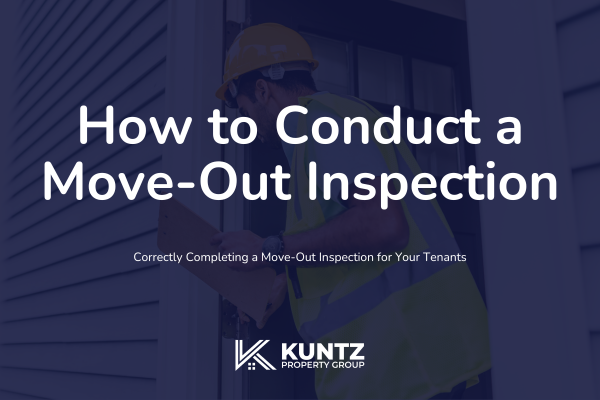Moving out can be as stressful for landlords as it is for residents. As a property owner, ensuring a seamless transition between residents is crucial for maintaining the integrity of your property and keeping it in top condition. When a resident moves out, it's your opportunity to inspect, document, and address any damage or issues that have happened during their residency.
This article will walk you through the essential steps of a move-out inspection, from conducting a thorough walk-through with your resident to planning necessary repairs, and how a Crestview professional property manager can ease the process.
Let’s start with how to conduct a thorough walk-through:
Conduct a Walk-Through with Your Resident
Before your resident leaves the property, it's important to conduct a comprehensive walk-through together.
This step is vital for several reasons:
By walking through the property alongside your resident, you can immediately identify and discuss any visible damage or issues. This helps to clarify what needs attention and prevents any disputes about the condition of the property later on.
Conducting the walk-through with the resident present ensures accountability because they are aware of the condition in which they are leaving the property and acknowledge any damage or issues that have happened during their stay.
Be sure to use this time to take detailed notes and photos of the property’s condition. This documentation will serve as valuable evidence should there be any disputes about the security deposit or damage responsibilities down the line.
How to Conduct the Walkthrough
If you are new to move-out walk-throughs, it can be overwhelming to think of all the things you should address. Even if you’ve done them before, a lot is going on during the move-out process, and having a shortlist of considerations can be quite helpful.
Keep these elements in mind to prepare:
Create a Checklist
Before the walk-through, prepare a checklist of all areas to inspect throughout the property, inside and outside. This should mention every room, including less obvious areas like basements, attics, and garages.
By creating this list ahead of time, you leave yourself more attention for the process of inspecting the property, rather than thinking through what areas you have and have not looked through.
Document Damage
Proper documentation is essential in the move-out process as it provides a clear record of the property's condition and helps protect both you and your resident. Throughout the walk-through, take plenty of photos and videos.
Be sure to use a high-quality camera or smartphone to take clear, detailed photos of any damage. Ensure that the photos are well-lit and focused. You should also consider capturing both wide shots of entire rooms and close-up shots of specific damage. This provides context and detail. If possible, use photos from the last move-in inspection as a reference. Compare these with the current condition to determine if the damage is new or pre-existing.
Discuss Damage with Resident
As you identify issues, discuss them with your resident. Make sure they understand what you consider normal wear and tear versus damage that requires repair and take detailed notes on what is agreed between all parties.
Discussing damage with your resident is a crucial step in the move-out process. It’s important to handle this conversation professionally and clearly to avoid misunderstandings.
Creating a Report
One aspect of the move-out walk-through that is often overlooked or under-considered is the detailed report.
Creating a report that includes descriptions of the damage, photos, and any relevant notes from the walkthrough is critical to ensure you have reliable records moving forward. Organize your report by room or area for easy reference and keep electronic copies of all documentation for easy access and sharing.
Key Points to Cover
Specific Issues: Address each issue you identified during the walkthrough. Be specific about the nature and extent of the damage.
Responsibility: Discuss which damages are considered normal wear and tear and which ones the resident will be held responsible for.
Security Deposit Impact: Explain how the damage will affect the security deposit. Will the full deposit be returned, or only a portion? Provide a breakdown of any deductions.
Communication Tips
While the conversation with your residents regarding damage can be tough, it’s essential to approach this conversation with a clear and fair mindset.
Use your documentation to support your points and encourage an open dialogue to ensure your residents feel heard and understood.
Allow them to share their perspective on the damage as they may provide context or information that you weren’t aware of.
If possible, reach a written agreement with the resident regarding the damage and any deductions from the security deposit that will be made.
Plan and Facilitate Repairs
Once you’ve completed a comprehensive walk-through and written up your report, it’s time to make all of the necessary fixes before your new residents arrive! Planning and facilitating these repairs efficiently ensures that your property remains in good condition and minimizes vacancy time, which means you save money.
Let’s take a look at a few of our top tips for putting repairs in action:
Steps to Facilitate Repairs
Assess the Damage: Review your documentation and determine the scope of the repairs needed.
Get Estimates: Contact contractors and repair professionals to get estimates for the work you need done.
Schedule Repairs: Schedule the repairs as soon as possible to ensure they are completed before your new residents move in.
Inspect Repairs: Once repairs are completed, inspect the work to ensure it meets your standards and your new residents won’t have any issues once they move in.
Choosing the Right Professionals
Choosing the professionals best suited to your job can be tough as there are so many options out there. We recommend that you always ensure any contractors or repair professionals you hire are licensed and insured.
Online reviews are also a great source of information when evaluating professionals and it is good practice to ask for references to make sure you are hiring reputable pros.
When you have a shortlist of the professionals you like best, get an estimate from each one to ensure you are getting a fair price for the repairs at hand.
Outsource to a Professional Property Manager
Managing move-out inspections and repairs can be time-consuming and stressful. Working with a professional Crestview property manager can help streamline the process and ensure everything is handled efficiently and effectively.
Professional property managers have the experience and knowledge to conduct thorough inspections and handle all aspects of resident interactions (even the most difficult ones). They can also take care of the entire move-out process, from the walkthrough to facilitating repairs, saving you time and hassle.
When choosing the right Crestview property manager for you, look for those with experience in managing properties similar to yours. In your initial conversations with them, evaluate their communication speed and style to make sure they match up with what you need. Last, but certainly not least, ensure the property manager offers the services you need, including move-out inspections, repair coordination, and resident communication.
Click here for a free rental analysis or to schedule a consultation!






